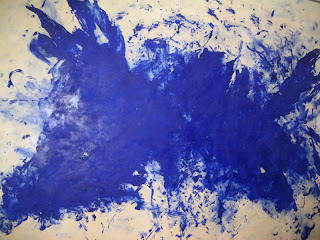"The imagination is the vehicle of sensibility. Transported by the imagination, we attain life, life itself, which is absolute art."
Yves Klein was the most influential, prominent, and controversial French artist to emerge in the 1950s. He is remembered above all for his use of a single color, the rich shade of ultramarine that he made his own, "International Klein Blue." But the success of his sadly short-lived career lay in attacking many of the ideas that underpinned the abstract painting that had been dominant in France since the end of the Second World War. For some critics he is a descendent of Marcel Duchamp, a prankster who lampooned settled understandings of painting and opened art up to new media. Others consider him as a descendant of earlier avant-garde artists such as Kazimir Malevichand Aleksander Rodchenko, who were also attracted to the monochrome. And even in the ways he used performance later on in his career, he is like many artists in the 1950s and 1960s who rediscovered some of the tactics of earlier avant-gardes. Klein might also be compared to his contemporary Joseph Beuys, for, like Beuys, he embraced aspects of Romanticism and mysticism - Klein was intrigued by Eastern religion and Rosicrucianism, and was even influenced by judo. Also like Beuys, many have condemned him as an obscurantist and a charlatan, yet the brevity, wit, and seductive beauty of much of his work continues to inspire.
The abstract painting that dominated French art in the 1950s was invariably premised on the notion that an artist could communicate with the viewer through the power of abstract form. But skeptics of modern, abstract art have always alleged that the viewers, like the faithful devotees of a false god, do more of the work than the artist, investing the forms with their own feelings rather than discovering the artist's. Viewed in this light, Klein's monochrome blue paintings might be read as a satire on abstract art, for not only do the pictures carry no motif, but Klein insisted there was nothing there at all, only "the void."
Klein's pictures may also be read in a contradictory fashion. He was genuinely fascinated by mystical ideas, by notions of the infinite, the undefinable, the absolute, and his use of a single rich and suggestive tone of blue might be seen as an attempt to free the viewer from all imposed ideas and let her mind soar. For, as Klein believed, lines in pictures were a form of "prison grating," and only color offered the path to freedom.
Throughout Klein's work, from his canvas monochromes to his later performances, there is a stress on immediate experience that reflects aspects of the Performance art movement of the 1960s. Although he was never specifically opposed to creating art objects, many of Klein's later works seem to want to abandon the object as a vehicle for art and instead find ways to more directly transmit ideas and experiences.








No comments:
Post a Comment